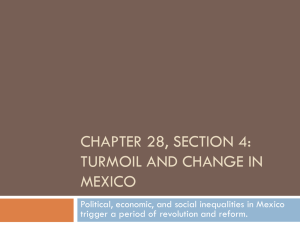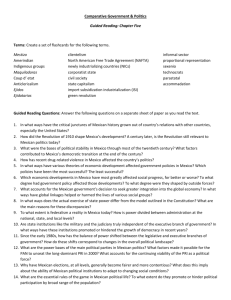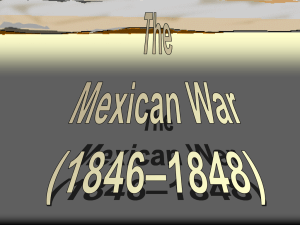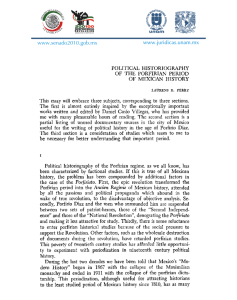The Porfiriato - Pasadena City College
advertisement
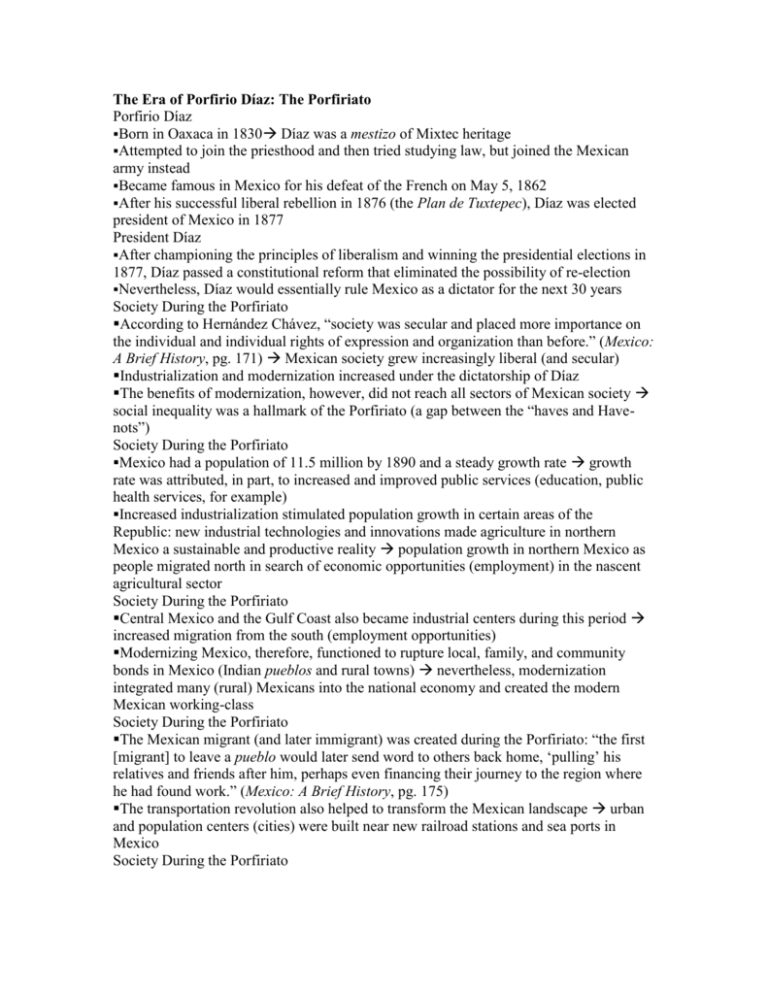
The Era of Porfirio Díaz: The Porfiriato Porfirio Díaz Born in Oaxaca in 1830 Díaz was a mestizo of Mixtec heritage Attempted to join the priesthood and then tried studying law, but joined the Mexican army instead Became famous in Mexico for his defeat of the French on May 5, 1862 After his successful liberal rebellion in 1876 (the Plan de Tuxtepec), Díaz was elected president of Mexico in 1877 President Díaz After championing the principles of liberalism and winning the presidential elections in 1877, Díaz passed a constitutional reform that eliminated the possibility of re-election Nevertheless, Díaz would essentially rule Mexico as a dictator for the next 30 years Society During the Porfiriato According to Hernández Chávez, “society was secular and placed more importance on the individual and individual rights of expression and organization than before.” (Mexico: A Brief History, pg. 171) Mexican society grew increasingly liberal (and secular) Industrialization and modernization increased under the dictatorship of Díaz The benefits of modernization, however, did not reach all sectors of Mexican society social inequality was a hallmark of the Porfiriato (a gap between the “haves and Havenots”) Society During the Porfiriato Mexico had a population of 11.5 million by 1890 and a steady growth rate growth rate was attributed, in part, to increased and improved public services (education, public health services, for example) Increased industrialization stimulated population growth in certain areas of the Republic: new industrial technologies and innovations made agriculture in northern Mexico a sustainable and productive reality population growth in northern Mexico as people migrated north in search of economic opportunities (employment) in the nascent agricultural sector Society During the Porfiriato Central Mexico and the Gulf Coast also became industrial centers during this period increased migration from the south (employment opportunities) Modernizing Mexico, therefore, functioned to rupture local, family, and community bonds in Mexico (Indian pueblos and rural towns) nevertheless, modernization integrated many (rural) Mexicans into the national economy and created the modern Mexican working-class Society During the Porfiriato The Mexican migrant (and later immigrant) was created during the Porfiriato: “the first [migrant] to leave a pueblo would later send word to others back home, ‘pulling’ his relatives and friends after him, perhaps even financing their journey to the region where he had found work.” (Mexico: A Brief History, pg. 175) The transportation revolution also helped to transform the Mexican landscape urban and population centers (cities) were built near new railroad stations and sea ports in Mexico Society During the Porfiriato Despite the increased “economic opportunities” in Mexico, the lives of most workingclass Mexicans were anything but “modern” or “progressive” working-class Mexicans faced harsh working conditions (long work weeks, long hours) and less-than-adequate remuneration and compensation Society During the Porfiriato The rapid pace of industrialization and modernization during the Porfiriato created deep social antagonisms in Mexico The upper and middle-classes, which benefited financially and materially from industrialization and modernization, were insensitive to the reality of lower-class life many in the upper and middle-classes even held the members of the lower-classes (i.e., the indigenous, the working-class, and the poor) in disdain or contempt Society During the Porfiriato Many of the social evils in Mexico (i.e., sexually transmitted diseases, alcoholism, crime, etc.) were attributed to the lower-classes resulting in a larger social divide between the Upper and middle-classes and the lower-classes Development of the Macho: it was during the Porfiriato that the Macho developed in Mexico men, particularly of the working and middle-classes, would frequently engage in amoral activities while demanding the utmost respect, especially from their wives Society During the Porfiriato As president (or dictator), Díaz was concerned with making Mexico a modern or progressive nation for Díaz, education was a essential for modernizing Mexico Picking up from where his rival Juárez left off, Díaz increased state spending on education The number of primary schools in Mexico increased from about 9K to 12K in the final quarter of the 19th century student enrollment also increased from about 200K to 800K during that same period Society During the Porfiriato Although state spending on secondary, preparatory, and vocational education was significantly less than spending on primary education, by the end of the Porfiriato in 1910, nearly 20 percent of the Mexican population was literate (the literacy rate throughout the 19th century was less than 15 percent) Society During the Porfiriato Public schools continued to be secular during the Porfiriato (and they continue to remain so) secular education was important because it “encouraged individuals to conceive of the world as a set of material circumstances that can be modified through the exercise of free will. With this worldview, the social actor was inclined to actively forge his or her own destiny rather than passively wait for other forces to define what was possible. It ushered in a new era in which merit, ability, and intelligence became the building blocks of social mobility.” (Mexico: A Brief History, pg. 179) Society During the Porfiriato For Díaz, the template for modernity were the European nations, France in particular (because of France’s level of industrialization and cultural sophistication) French culture, therefore, was the culture to be admired and imitated in Mexico upperclass Mexicans often dressed in French fashions, owned French furniture, ate at the most exquisite French restaurants, etc. Díaz redecorated El Paseo de la Reforma so that it could resemble the Champs Elysées Society During the Porfiriato In the early 20th century, Díaz ordered the construction of a national opera house (now known as El Palacio de las Bellas Artes) in downtown Mexico City, modeled after European art houses The finest French marble was imported from France for its construction Society During the Porfiriato The leftover French marble was used in the construction of a monument for the 100th anniversary of Mexican independence the monument is known as El Ángel de la Independencia The Mexican Economy During the Porfiriato The vitality of the Mexican economy after the restoration of the republic in 1867 continued during the Porfiriato A steady increase in International trade contributed to the propitious Mexican economy Increased mining also contributed to the thriving economy in the late 19th century, industrial innovations (new mining technologies and machines) increased the productivity of the mining sector Growth of the mining sector also led to the discovery of new energy sources, particularly coal and petroleum The Mexican Economy During the Porfiriato The increased productivity of the mining sector and the discovery of new energy sources attracted foreign investment in Mexico and increased Mexican exports Although alternative energies were discovered, Mexico lacked electricity or electric power only the largest cities (such as state capitals) contained an electrical infrastructure Mexican Political Structure During the Porfiriato The various forms of electoral participation that existed after the restoration of the republic in 1867 persisted and, indeed, became more limited during the porfiriato Since municipios and states continued to define citizenship and electoral rights, the Porfirian government also decided to set voting criteria and qualifications for Mexicans voting at the federal level, which included: Having “an honest means of earning a living” A minimum level of financial or material wealth Literacy Military service demonstrable level of patriotism Mexican Political Structure During the Porfiriato By limiting the qualifications of Mexicans voting at the federal level of government, the Porfirian government maintained what was essentially a monopoly on federal authority the reason why Porfirio Díaz remained president for over thirty years, despite the no re-election reform legislation The Mexican government during the Porfiriato, therefore, was essentially an autocracy (federal authorities hand-picked their successors), with Díaz as the country’s dictator Mexican Political Structure During the Porfiriato Throughout the course of the 1880s, 1890s, and early twentieth century, the government’s authority became increasingly authoritarian, the electoral process was corrupted (specifically, federal and state elections were rigged), and the government neglected public services These factors created a disconnect between the Mexican people (primarily the rural population and the lower classes) and the federal government the Mexican population turned to local municipios for political and public support Mexican Political Structure During the Porfiriato “Given the disconnect between the governing elite and the rural population, these two groups drifted further apart. The social and political response of the communities was to reject the new impositions, and all external authority along with them. [The rural population] argued that their political rights were being continually eroded [by the federal government].” (Mexico: A Brief History, pg. 190) Breakdown of the Porfiriato Because of the government’s neglect towards Mexican society, in the early 20th century several sectors of Mexican society (including members of the working and middle classes) began to debate new forms of representation at the federal level a rebirth of the liberal movement in Mexico Liberal demands (including universal suffrage, no re-election, a true implementation of the 1857 Constitution) were articulated through a variety of mediums in Mexico, including: Newspapers and printed media Labor protests and strikes Public entertainment (i.e., theater) Breakdown of the Porfiriato Also in the early 20th century, there were divisions among officials within the federal government the Porfirian government was increasingly becoming internally divided in the early 20th century, nevertheless Porfirio Díaz remained in power as president Díaz’s support of the Church was one reason why the Porfirian government was internally divided Díaz gave the Church many social and economic privileges (tax reductions or exemptions, for example) Díaz’s favor towards the Church also caused discontent among the Mexican people as federal support of the Church directly contradicted the 1857 Constitution Breakdown of the Porfiriato In an interview in 1908, Díaz announced that he would not run for re-election in 1910 Díaz’s statements had a profound impact in Mexico as several liberal political parties were established and members of the Porfirian political elite further distanced themselves from their colleagues in order to acquire higher positions of political authority in short, there was a splintering of Porfirian authority in Mexico Breakdown of the Porfiriato In 1909, Díaz had a “change of heart” and decided to run for re-election in 1910 Díaz’s decision to run for another term added further fuel to the fire of popular liberal movements that had developed throughout Mexico On the eve of the 1910 elections, then, the Mexican nation was divided into two camps: those in favor of re-election (re-election entailed the perpetuation of Porfirian practices in Mexico) those opposed to re-election (the end of Porfirian practices and the implementation of liberal principles





